Hoe uw klanten verliefd op u kunnen worden
7 eenvoudige geheimen voor een beter product en eenvoudigere verkoop
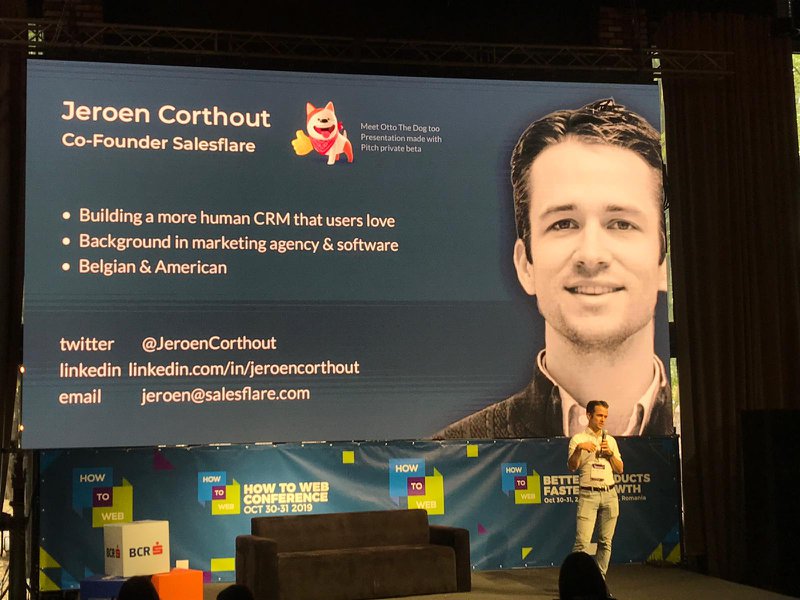
Precies een week geleden sprak ik op HowToWeb 2019 in Boekarest, Roemenië. De tiende editie van een mijlpaalconferentie in de CEE-regio.
Ik was vereerd om deel uit te maken van zo'n high profile spreker line-up, waaronder thought leaders als Sean Ellis (growth hacking), April Dunford (positionering), Bob Moesta (Jobs-to-be-Done) en Michael Perry (ondernemerschap).
The theme of the conference is “Better Products, Faster Growth” and that’s what I was asked to talk about as well.
As the local tech ecosystem is gearing up, there’s still a gap between ambitions and execution, especially when it comes to building products that people want and then managing to sell them.
That’s why I shared 7 principles that make a big difference when starting off a product business, in the hope to bring some inspiration to the founders or aspiring founders in the room.
Coincidentally – or not – many of my fellow speakers touched on these same topics during their talks. I’ve linked to those talks wherever I can, so you can go into that too if you like.
Alles klaar? Werken de microfoon en de clicker?
3 – 2 – 1. Here we go 😁
Hoe je klanten verliefd op je kunnen worden
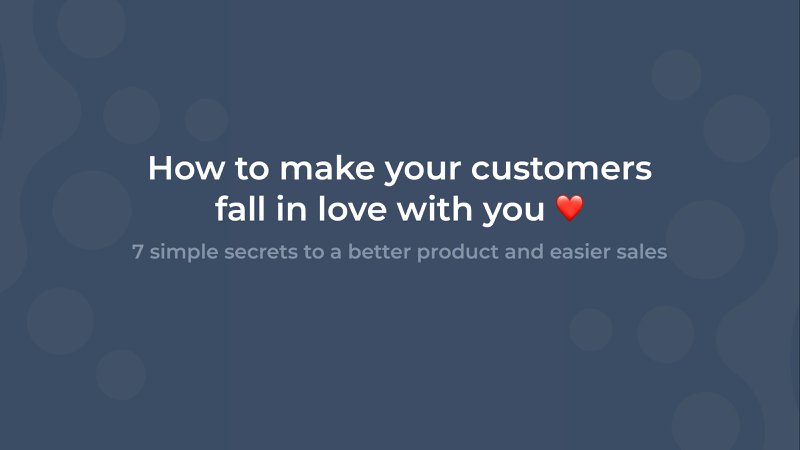
Hello everyone! I’m Jeroen of Salesflare. My goal with this talk today is to help you develop a product and a sales process your customers can fall in love with.
I’ll be sharing some simple but fundamental secrets on how to do that. I hope that’s what you came to this talk for. If it is, sit tight!
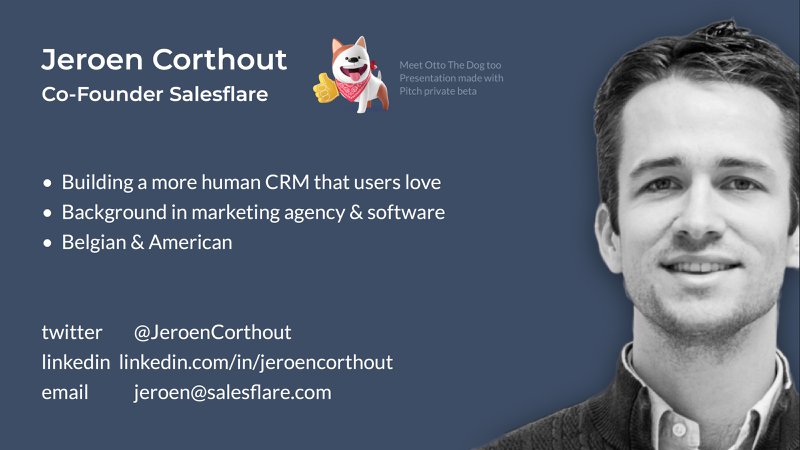
About me: like I said, I’m Jeroen, co-founder of Salesflare, which is a CRM software company.
Tussen meer dan 600 concurrenten valt Salesflare op met een gebruiksvriendelijk en geautomatiseerd CRM-product waar het MKB dol op is.
Mijn persoonlijke achtergrond is in een marketingbureau en in softwareontwikkeling, net als de meesten van jullie neem ik aan.
And I come to you and HowToWeb from the country of beer, chocolate and waffles, called Belgium. I’m also a US citizen by birth, as I was born in a little town in upstate New York.
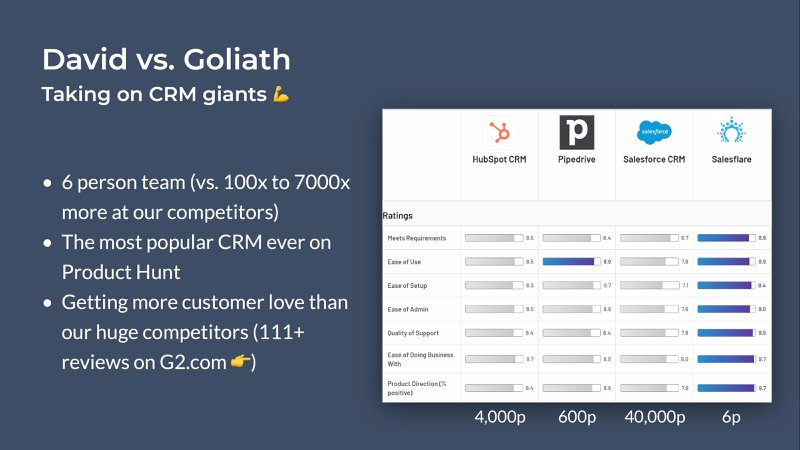
Dus als je Salesflare als bedrijf vergelijkt met onze belangrijkste concurrenten, zul je waarschijnlijk getroffen worden door het feit dat we honderden tot duizenden keren kleiner zijn dan hen in termen van headcount.
Toch bedienen we duizenden klanten met een vergelijkbaar product en krijgen we veel meer liefde van onze klanten dan onze concurrenten, zoals blijkt uit onze scores op G2 hier rechts.
Deze lezing helpt je te begrijpen hoe je hetzelfde effect kunt creëren. En hoe je als klein, opkomend bedrijf een beter product kunt maken en gemakkelijker kunt verkopen.

Bij Salesflare hebben we in feite een klantwaarde-machine gebouwd die laser-gefocust is op het creëren van waarde voor klanten.
Dat betekent dat we twee dingen doen: 1. we praten met klanten en 2. we bouwen een waardevol product en waardevolle inhoud voor hen waarmee ze beter kunnen worden in wat ze doen.
En we doen dit alles in een zeer snel en constant tempo.
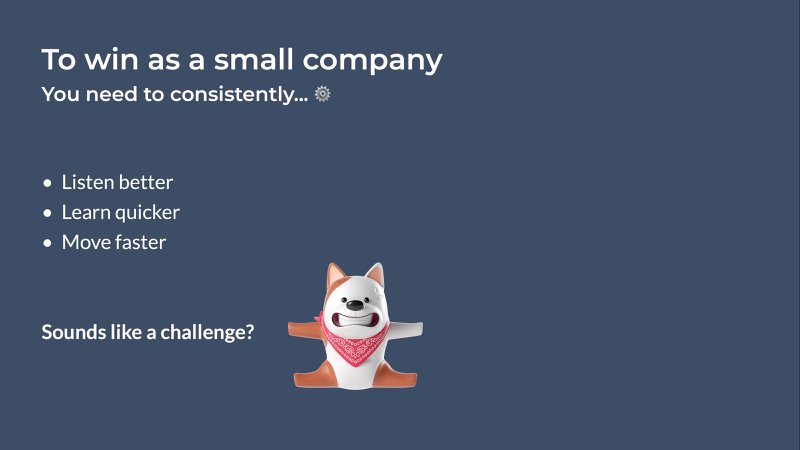
Om als klein bedrijf te winnen, zijn inzicht in de klant, snelheid en consistentie essentieel.
It’s your weapons against the giants in your space. It’s your well aimed slingshots that can defeat them.
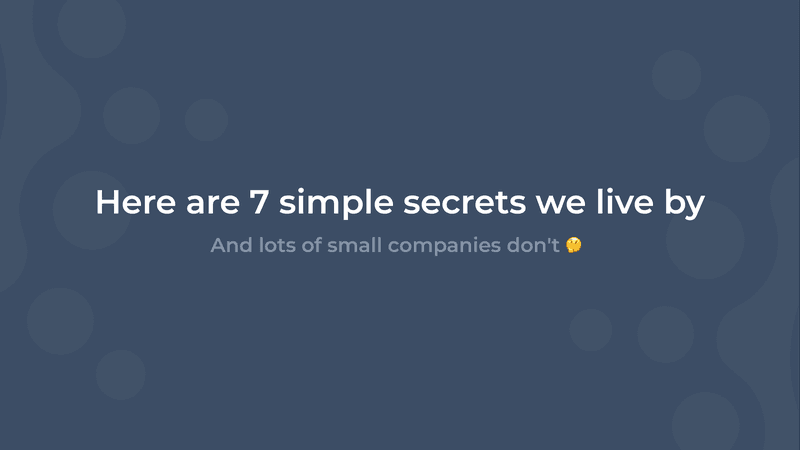
Hoe kun je deze 3 dingen bereiken? Nou, laat me je vertellen hoe we dat doen.
And I’m not going to tell you our way is the only way and you need to copy it literally, but at least I hope I can inspire you with our approach.
So let’s start with the very simple but fundamental basics, with rule nr 1 …
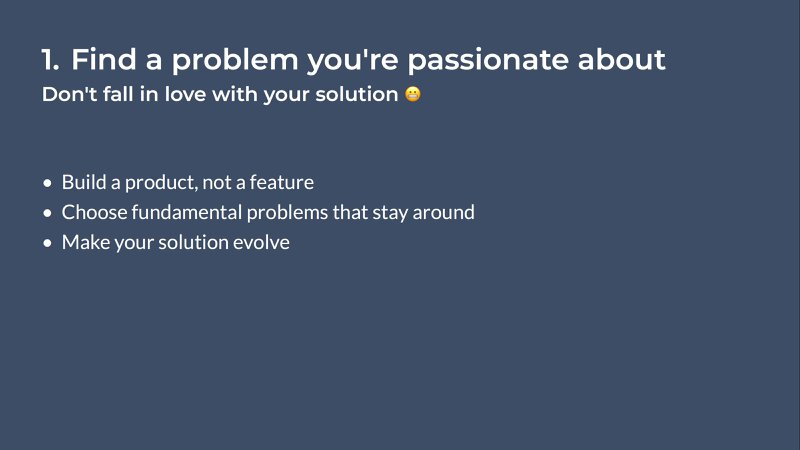
… which is to “find a fundamental problem you’re passionate about”.
Het probleem waar wij ons bij Salesflare op richten is slechte CRM data; en we helpen bedrijven om hun klanten blij te maken door middel van betere data.
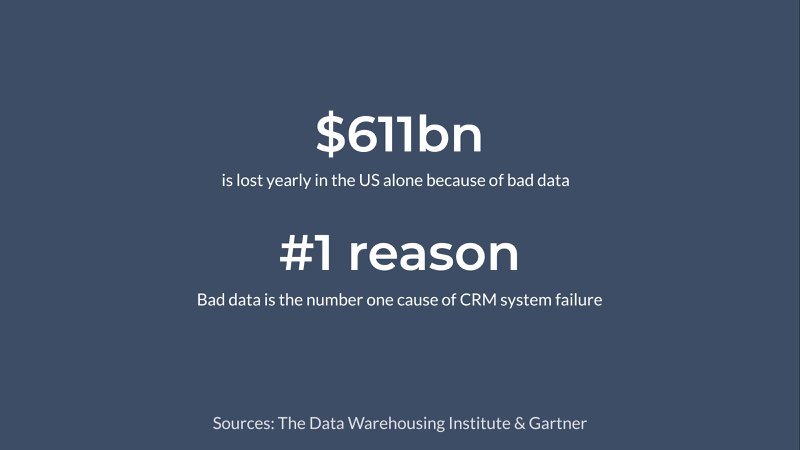
The initial solution we came up with and that we offer is automated collection of data from emails, calendar, phone, … but that’s not really where we stop. We are thinking about integrating new communication channels, we are thinking about adding new ways of combining data, about adding new types of sales intelligence, and even maybe about completely different things that solve the same issue or reinforce our solution.
It is after all really dangerous if you’re just building a feature, like -say- software that automatically imports email signatures and adds them to your contact database.
Dit soort functies kunnen heel snel verouderd raken als bijvoorbeeld Google, Microsoft of Apple besluiten om ze toe te voegen aan hun e-mailoplossingen. In dat geval ben je zo goed als dood.
Integendeel, terwijl oplossingen en functies gemakkelijk worden gekopieerd en vervangen, blijven problemen wel bestaan en vormen ze een veel sterkere basis voor je bedrijf.
This is something that my fellow speaker Michael Perry from Shopify will discuss in his talk later on about his 13 year journey in startups, as one of the mistakes he’s made along the way. (Check it out in the Facebook Live video here at the -0:45 mark; this talk made me quite emotional and the message Michael’s bringing is a very important one, so don’t miss out.)

Now, after you’ve found some fundamental problem, you should verify that it’s a problem that a group of people face, that you can actually identify with.
In ons geval zijn onze gebruikers meestal bureaus (ik heb vroeger bij een marketingbureau gewerkt) en aan de andere kant softwarebedrijven (uiteraard run ik op dit moment een softwarebedrijf).
Ook al is dit een overvolle ruimte, we weten heel goed hoe bureaus en softwarebedrijven werken, we kennen hun problemen en we kennen er ook veel van. Dat helpt ons enorm.
Sometimes people tell me that we should focus on another, much easier market. And often it comes up that there’s huge potential in the market for, for instance, a better CRM for real estate. This would indeed be way easier, as the real estate market is rather underdeveloped in terms of software solutions, and especially in terms of CRMs.
The thing however is: I wouldn’t be hanging out with you here and I wouldn’t be having conversations that genuinely interest me. Instead, I would be hanging out at a real estate conference and I would be eating my heart out.
Real estate people are not really “my people”. I don’t enjoy talking about selling real estate that much. And how badly actually would our company do if I didn’t enjoy talking to our customers.
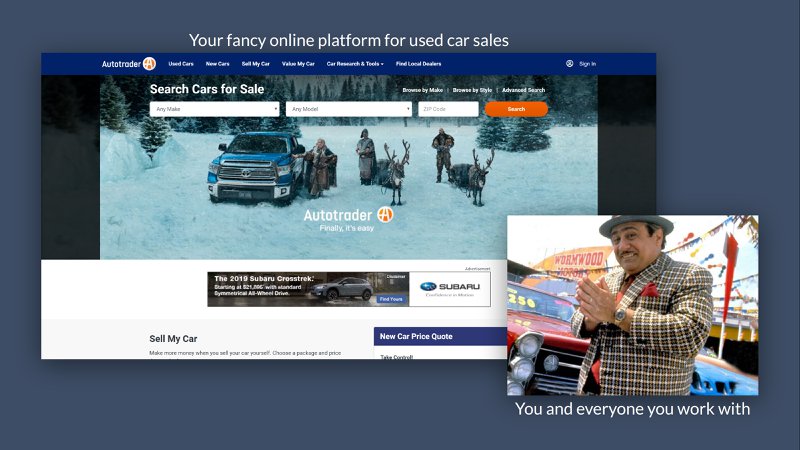
Hypothetically, it could also be that you’ve seen a once in a lifetime opportunity in building an online platform for second hand car sales.
Maybe you’d think: “I’m building it for people like you and me, I will like this”; but in the end, you will be a used car salesman, meeting and competing with other used car salesmen, and you might start feeling miserable after a little while if this doesn’t fit you.
Als je deze gedachtengang en regel verder volgt, is de ideale situatie dat je eerst een gelijkgestemd publiek opbouwt dat jou leuk vindt en vertrouwt, en vice versa. Pas dan ga je achter hun problemen aan en pas dan creëer je een oplossing.
Now, we don’t all have that luxury, but if you can at least create something for people you like and understand, it will move you a big step forward yet again.
If you’ve seen April Dunford’s talk this morning, you also understand that selecting your audience will define your positioning and product to a large extent, so don’t mess it up. (Kijk naar haar praatje in de Facebook Live video hier op -6:26:00 mark. Het kan het verschil maken tussen succes en falen van je bedrijf.)
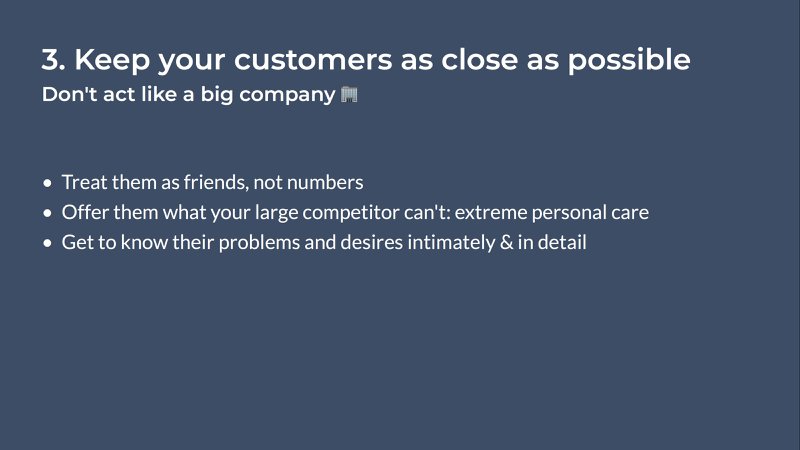
Third, it’s very important as a small company to play out your advantage as a small company. And not to start acting like a big company.
Will the CEOs of our competitors get on onboarding calls with their customers, connect with them on LinkedIn or Facebook, help them to solve their issues personally, … ? I think, with the exception of some key customers, no, they definitely won’t.
We have thousands of customers using our software and as we work very closely with them, I still know personally who many of them are, what they care about, how they think, …
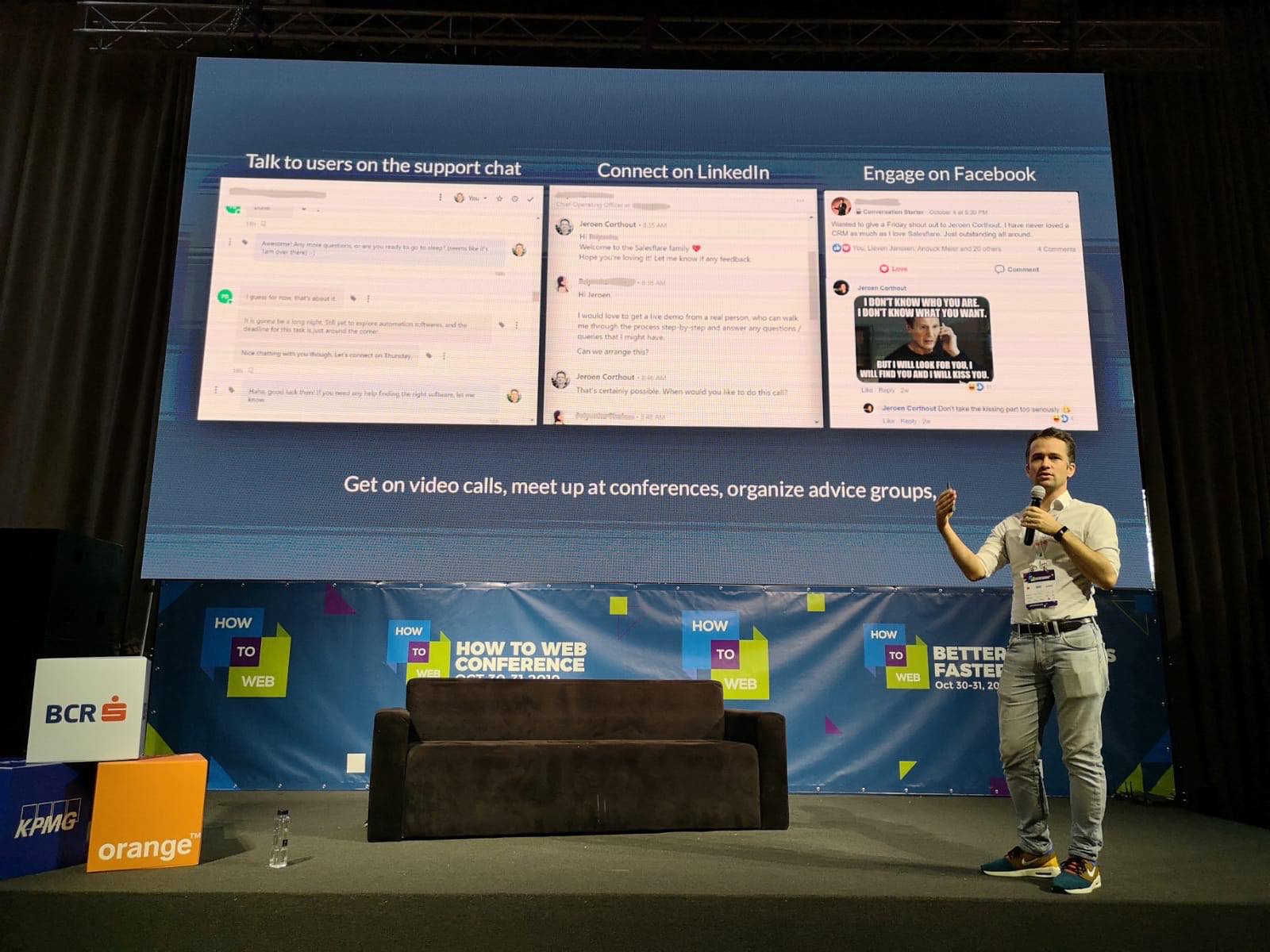
All in all, I think being in touch with customers takes about 10-20% of my time, but it’s my best spent time. And it’s worth it. It gives me energy, it helps us to understand our customers, to build stronger relationships, … It’s really the best spent time of all.
Still, I see many companies trying to act like a big company, because they believe it’s the only way to get credibility and to be trusted; I tell you: there’s a much better way to gain their trust and it’s investing in a strong relationship; this will pay off big time.
Back to the G2 chart I showed earlier, you can see there that “ease of doing business with” Salesflare is our highest score by far. That’s not a coincidence. It’s a direct result of our focus on close relationships with our customers.
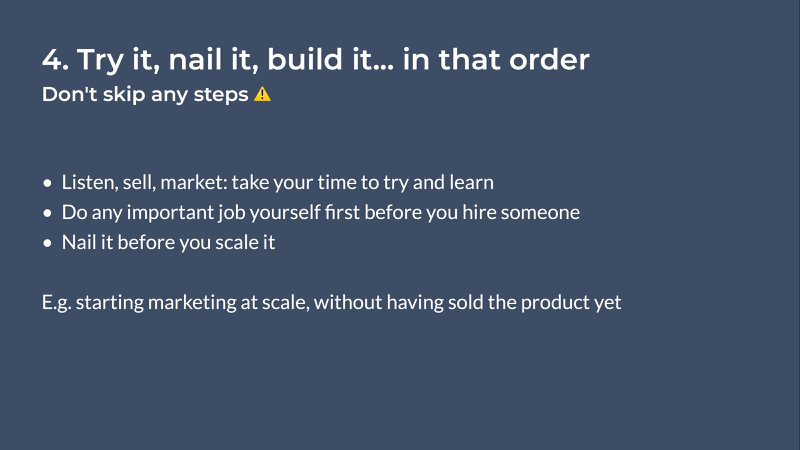
The fourth important rule is not to skip any steps along the way. You’ll often be tempted to do it, but just don’t.
Omdat veel mensen onze marketingaanpak bij Salesflare waarderen, krijg ik vaak de vraag van startende ondernemers hoe ze hun marketing moeten aanpakken.
And when they do and we meet up, I’ll first start with listening to what they sell, to whom they sell it, and then I will ask: “So how many people have you sold this to already?”
Almost invariably, the answer will be between 0 and 5 people, which means they haven’t even figured out a way to get repeated sales – so why on earth would they even care to start marketing?
En dit is slechts een symptoom van een groter probleem, omdat kleine bedrijven in het algemeen te snel groot willen zijn en onderweg op alle fronten essentiële stappen overslaan.

When my co-founder and I started Salesflare, the first thing we did is reading the book “Getting Real” by 37signals (which I can very much recommend – and it’s free) and we rigorously applied the principles from that book; we first made a presentation, and we made a mockup, and we started doing lots of interviews to understand what people needed and why they’d see us fail at building Salesflare.
Ever since then, everything we have done at Salesflare we have first tried manually and at its most basic level, and then we have repeated this until we nailed it, and only then we’ve scaled it.
As an example, for 1 to 2 years I’ve personally gone on Skype calls with screen sharing to onboard customers on our software, connect their emails, do their imports, see what they didn’t understand or lacked. And I could experience everything firsthand. It gave me very direct pain.
If, instead, we would have made a fully self-service onboarding from the start, I’m certain we would have missed so many learnings and we would have spent so much more time perfecting Salesflare, if by then we wouldn’t have run out of money already.
Of course, we have made many mistakes too, like hiring people before we nailed the job ourselves, which made iterating to find the right solution ten times slower. That’s why I recommend to you: do the job first yourself, and only then get someone else to do it better than you. But figure out the basic strategy before you hire that person, otherwise you might easily get stuck in the very same place.
Actually, a great example of the “nail it before you scale it” way of thinking is how the guys at Sympl, the company with whom we share an office, built out their full recruitment solution first using 1. Zapier, 2. a simple database solution and 3. Slack.
They didn’t start coding at all. Instead, they first made sure they knew exactly what they wanted to code, and they saved months -if not years- doing so.
If you haven’t seen yesterday’s talk by fellow speaker Paolo Ertreo from Dropbox, check it out online. It’s full of great insights in how to do iteration right, and it’s applicable to both your product and your sales. (Check out his talk in the Facebook Live video here at the -0:36:30 mark. You’ll always remember the pebbles and boulders analogy.)
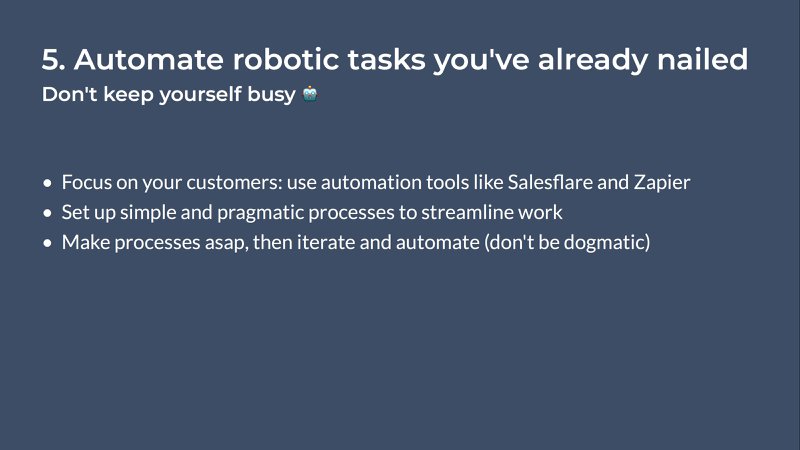
Fifth, once you’ve nailed some of the tasks, start automating them.
When I’m saying “nail it before you scale it”, that obviously doesn’t mean you should keep yourself busy with groundwork for the rest of time.
Again, if you’re in a software company or you’re in an agency, you have two jobs: 1 is talking to customers and 2 is building valuable stuff for them. Everything else is secondary and should be as automated as possible, as soon as you have nailed it.
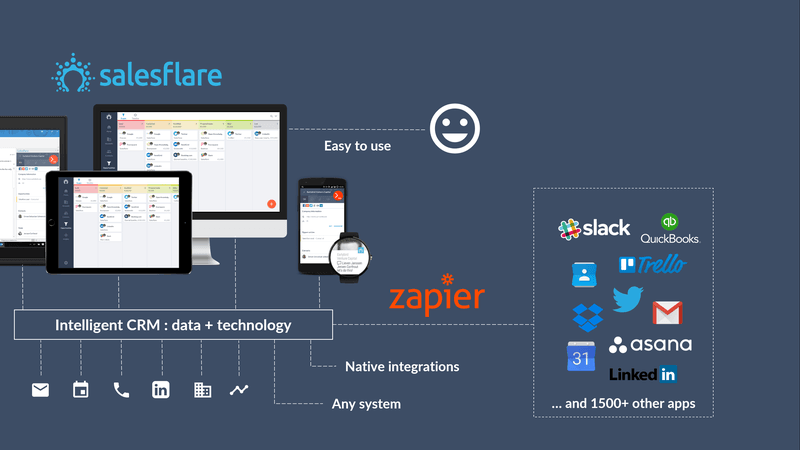
Salesflare itself, the product, was created to scratch an automation itch we had ourselves, which was having to document our every interaction with customers, plus their details. This is of course essential to be able to talk to customers, but it’s not the talking to customers itself. It only has a supporting role, it’s robotic work, and we believed it should be automated. In fact, we’ve already proven that computers do a much better job at this than we do.
Next to using Salesflare, and at Salesflare, we have tens of other software products running for us that automate the little things in our workflow and we all connect them together with Zapier, so it kinda all runs like a clockwork and we don’t need to spend our time moving data from here to there. It just runs by itself for us.
Belangrijk om op te merken is dat een groot deel van het automatiseren van je werk vaak eerst een eenvoudig proces is om het beter te organiseren. Dit voorkomt een hoop nutteloze communicatie als je het eens bent over hoe je samenwerkt, plus het maakt het daarna vaak gemakkelijker om te automatiseren.
Als je iets voor de 10e of 20e keer doet en je weet hoe het het beste werkt, begin het dan zeker te documenteren en automatiseer of delegeer het dan.
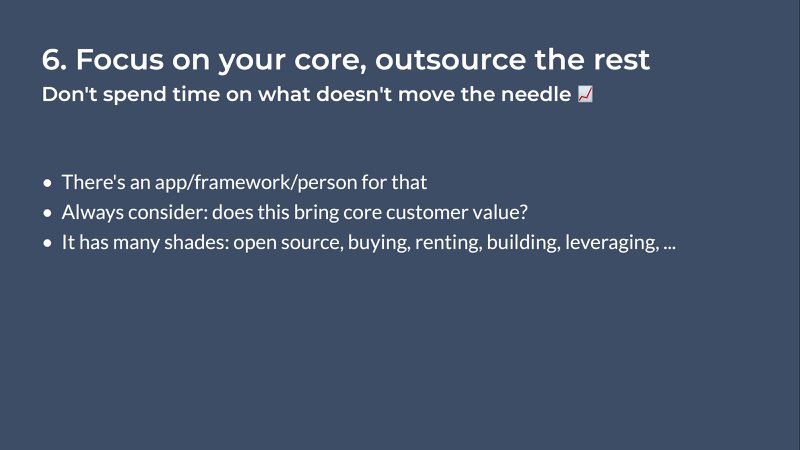
So imagine again being 6 people and competing with companies that are hundreds to thousands of times bigger… and you want to do better. In this case, you need to be very focused at doing the exact right things better.
Today, and thanks to the internet and everyone contributing to it, it’s easier than ever before for small companies to build your software and reach your audience, without needing to take care of all the secondary things.
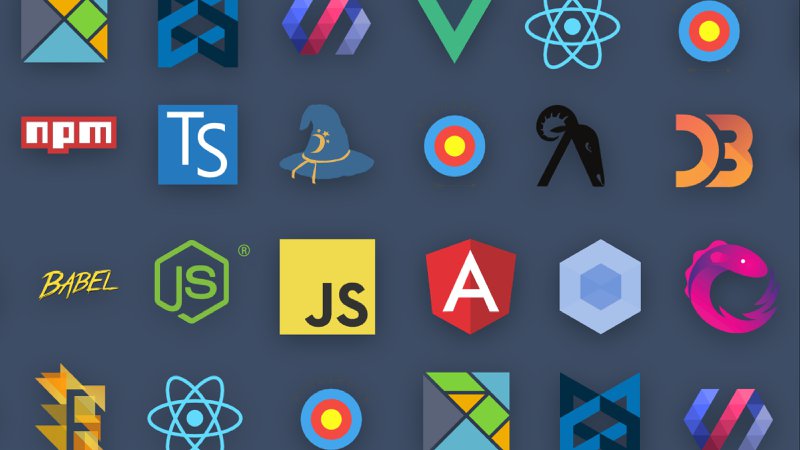
Even if you obsess about UX like we do, you don’t need to build your own UI components. You can just use a framework.
Even if your main premise is to pull data from everywhere, you don’t need to build your own connectors; at least certainly not at first.
We zijn bijvoorbeeld begonnen met een extern platform om e-mails te synchroniseren, dat we pas twee jaar later hebben vervangen door onze eigen integratie, omdat we begrepen dat het zinvol was om deze technologie naar onze kern te verplaatsen.
This makes that our CRM now has the fastest, most stable and most powerful email integration around with Google Workspace and Office 365, which is now a competitive advantage vs the rest. So it was an important thing to do, but it wasn’t important to do this from the very beginning.
Kijk voor alle dingen die nu geen deel uitmaken van je kernwaarde naar creatieve manieren om sneller te bouwen wat je nodig hebt. En er zijn heel veel manieren om dat te doen.
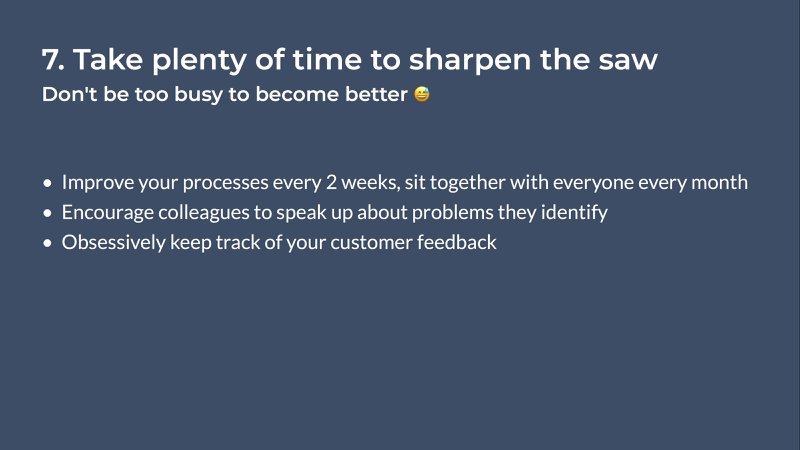
Last but not least, neem de tijd om te verbeteren.
For those who haven’t read Stephen Covey’s “The 7 Habits of Highly Effective People”, coincidentally their 7th habit is the same as the 7th habit of highly effective small companies: never be too busy sawing, to stop and sharpen the saw.
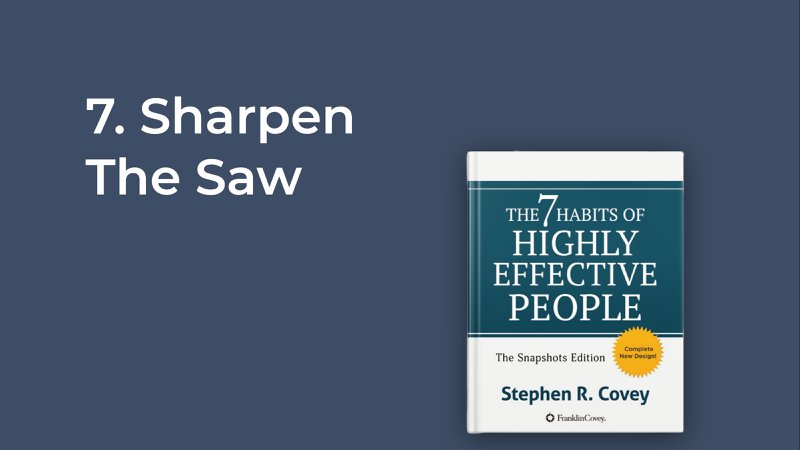
Your main goal should remain to beat the status quo and to become a better company than yesterday. Even if it’s just with 1% increments every day, it will all add up in the end.
What we have done for five years straight now is sit together with the whole team every two weeks for two or three hours and discuss what’s going well and especially what’s not going well.
We schrijven dit op een whiteboard en reserveren genoeg ruimte voor oplossingen voor de negatieve punten en voor lessen voor de positieve punten. En dan werken we aan de oplossingen en gebruiken we de lessen.
We moedigen ieder van ons aan om problemen te identificeren, niet om ze te negeren, zodat we uit onze status-quo of comfortzone kunnen stappen en ze kunnen oplossen.
En hetzelfde geldt voor hoe we met klanten werken. We moedigen hen actief aan om ons feedback te geven en belonen hen met persoonlijke berichten als we later naar aanleiding van hun feedback actie ondernemen.
It’s only because we care deeply about becoming better, that we can actually outperform our competitors and get these amazing customer review scores I showed you at the beginning.
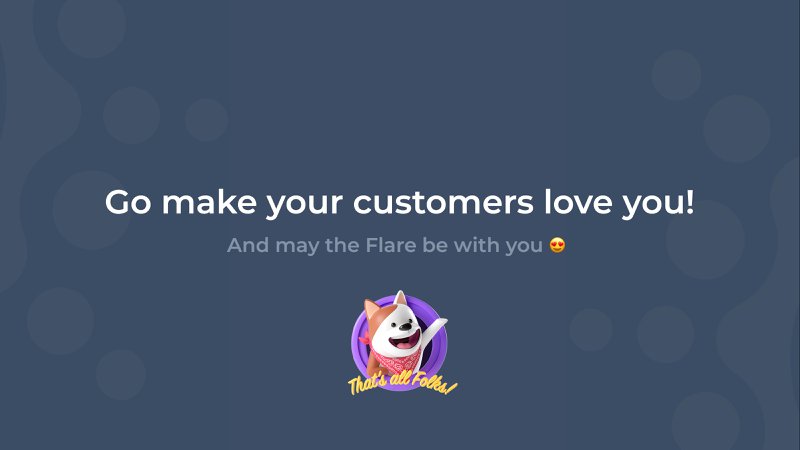
And that’s it. Those are our 7 simple secrets. I hope you’ll be able to take at least one of them home and use it to improve your business.
Ga nu en zorg dat je klanten verliefd op je worden!
Dank je wel! En moge de Flare met je zijn!
P.S. Deze presentatie is gemaakt met de privébètaversie van Pitch. Vandaar de Otto The Dog stickers. Je kunt ook genieten van de presentatie op deze openbare link.
“Salesflare is smart and turns CRM from something “I have to do” into a tool that helps me focus on why I started my business.”
Michael Clingan, De Claymore Group

We hopen dat je deze post leuk vond. Als je het leuk vond, vertel het dan verder!
👉 Je kunt @salesflare volgen op Twitter, Facebook en LinkedIn.
- 8 Voordelen van CRM + 6 uitdagingen om eerst te overwinnen - 18 april 2024
- 30+ Beste Leadgeneratie Tools (per Type) - 16 april 2024
- 7 Beste CRM's voor Google Workspace + Integratiefuncties - 11 april 2024
